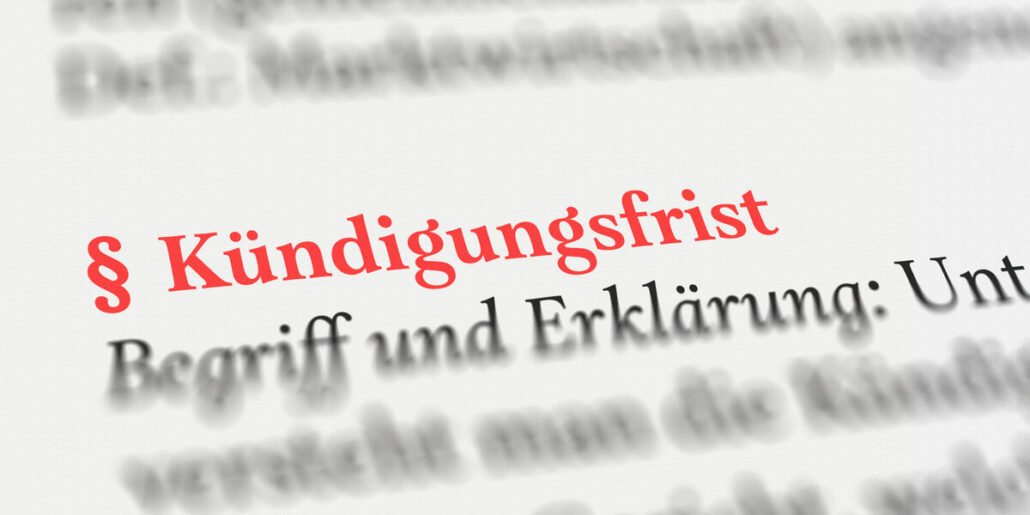

Losing your job rarely means that your employment ends the next day. In most cases, there is a notice period. You keep working – or you are released from work (“Freistellung”), but still stay employed and get paid. How long depends on your contractual notice period, any collective agreement, and how long you’ve been with the company. The latter is especially true for statutory notice periods. In our guide, we walk you through different notice periods step by step. So you know your rights and don’t leave money or time on the table.
Calculate your severance payment
Calculate the settlement amount for your individual case in 2 minutes
Key takeaways
- Notice periods are usually set in the employment contract or a collective agreement. Only if these rules are missing or invalid do the statutory notice periods apply as a fallback.
- Statutory notice periods clearly distinguish between employee and employer. Employees usually have a fixed notice period of four weeks, while notice periods for employers increase with length of service.
- How long you actually keep working after notice depends on more than the formal notice period. Remaining holiday, overtime and agreements about garden leave can shorten the time you still have to work in practice.
- Collective agreements can extend or shorten notice periods significantly. In some sectors they replace the statutory rules fully, so you must always check which agreement applies to your job.
- Notice periods matter financially for both sides. For employers they define how long the salary must be paid. For employees, on the other hand, they affect planning, unemployment benefits, and the timing of any new job.
Contents
Notice periods for ordinary termination
If an employer or employee wants to end an employment relationship by ordinary termination, they must comply with the applicable notice periods. These ordinary notice periods are almost always regulated in the employment contract and sometimes in a collective agreement. Only if there is no contractual notice period, the statutory rules in the German Civil Code apply.1
Statutory notice periods depend mainly on who gives notice. For the employee, the statutory notice periods are always the same. For the employer, the notice period increases with the length of service. How long you actually continue working after a termination depends not only on the notice period. However, it also depends on remaining holiday and individual agreements, for example if the employer releases you from work (Freistellung).
Before you sign a termination agreement, always check three things in this order:
- what your contract and any collective agreement say about notice periods
- what the statutory minimum would be if these clauses were invalid
- whether the proposed end date really respects the applicable notice period
If something does not add up, in your opinion, documentation is key. Keep all emails and letters from HR and get legal advice before signing, instead of trusting verbal assurances.
Exception: Collective agreement
If a collective agreement applies, its rules on notice periods often take priority. Collective agreements can shorten or lengthen notice periods compared to the statutory rules. In the public sector, for example, the relevant collective agreement contains special rules on notice periods. If the contract grants a longer notice period than a collective agreement, the more favourable rule for the employee applies. Trade unions and works councils are often good contact points if you are unsure which collective agreement applies. And which termination rules you must observe.

Free initial consultation with a specialist lawyer
- Free initial consultation with a lawyer
- Quick callback after 1 to 2 hours
- Strategy for negotiating the severance pay
Statutory notice periods for employees
An employee can ordinarily terminate the employment relationship with a statutory notice period of four weeks. The law allows termination to the 15th of a month or to the end of a calendar month. During the probationary period, which can last up to six months, the statutory notice period is two weeks to any day, so resignations can take effect on any calendar date.
Priority of contractual agreements
In practice, agreements in the employment contract override the statutory rules, as long as they are not less favourable than the law. Most employment contracts define a specific notice period for both sides, often one to three months, sometimes longer. There is no explicit statutory upper limit for the contractual notice period of employees, but case law sets boundaries: the Federal Labour Court has held that a notice period of three years for employees is unreasonably long and invalid.2
Shortening the statutory notice period to the disadvantage of the employee by contractual notice periods is generally not legal. Exceptions may apply for short term temporary staff who are employed for no longer than three months or in carefully designed special contracts. It is also common to limit termination dates, for example by allowing termination only at quarter end instead of month end, which effectively reduces the number of possible termination dates per year and makes spontaneous job changes harder.
Exceptions for small businesses
Special rules apply to certain small businesses. These employers can agree on different termination dates, for example only to the end of a month, while still respecting the minimum four week notice period. Small employers must, however, respect basic fairness: contracts may not impose longer notice periods on employees than on the employer. A longer notice period for the employer is allowed and often beneficial for employees, because it makes dismissals more expensive and offers more planning security.
Summary of statutory notice periods for employees
If there is no contractual notice period or the contract refers to the statutory rules only, the statutory notice periods for employees are rather straightforward. During the probationary period of up to six months, the notice period is two weeks to any day. After probation, the notice period is always four weeks to the 15th or to the end of a calendar month, whether you have been with the company for two years or twenty. In practice, most contracts replace this with a uniform longer period, usually one to three months, which is allowed if it applies equally to both sides.
| Length of employment | Notice period |
| 0-6 months | 2 weeks to any date |
| Ab 6 months | 4 weeks to the 15th or end of the month |
Calculate your severance payment
Calculate the settlement amount for your individual case in 2 minutes
Statutory notice periods for employers
For employers, the legislator has set up extended statutory notice periods to protect employees. The statutory notice period for an employer depends on the length of continuous service of the employee. The longer someone has worked in the company, the longer the employer has to wait until the termination becomes effective.3
Within the first six months of employment, both sides can terminate with two weeks notice to any day. From seven months to two years of service, the basic notice period for the employer is four weeks to the 15th or to the end of a month. After two years of continuous service, the notice period for the employer increases step by step and can reach up to seven months to the end of a month after twenty years of service. In detail, the statutory notice periods for employers look like this:
| Length of employment | Notice period |
| 0 to 6 months | 2 weeks to any day |
| 7 months to 2 years | 4 weeks to the 15th or end of the month |
| From 2 years | 1 month |
| From 5 years | 2 months |
| From 8 years | 3 months |
| From 10 years | 4 months |
| From 12 years | 5 months |
| From 15 years | 6 months |
| From 20 years | 7 months |
In practice, many contractual notice periods replace this statutory graduation with a uniform longer notice period, often one to three months, that is the same for both sides. It is also possible to agree that the longer statutory notice periods that formally apply only to employers will also apply to employees. This is common in contracts for higher level positions and can increase the value of the job protection if a dismissal ever occurs.
Notice period calculator
Notice periods are usually set out in the employment contract. Only if not, statutory notice periods apply: employees must give four weeks’ notice, while employers face longer, staggered notice periods, depending on the employee’s length of service. During probation, the statutory notice period is 2 weeks.
Free initial consultation with a lawyer
Quick callback after 1 to 2 hours for a free initial consultation with a lawyer
Deviations and special cases
If a collective agreement is in force and provides notice periods that differ from the statutory rules, the collective agreement usually takes precedence. This can lead to shorter or longer notice periods than those in the Civil Code.
Many collective agreements also contain special rules for notice periods during probation or for specific groups of employees, such as trainees, public servants or certain shift workers.
During probation, which may last for up to six months, both sides can usually terminate the employment with a notice period of two weeks. This allows a quicker separation if it becomes clear that the employment relationship does not work. However, even in probation, the rules in any applicable collective agreement and the exact wording of the contract must be respected, and employees should keep letters, emails and performance reviews that might later be needed if a dismissal is challenged.
There are also special statutory notice periods for particular groups. For example:
- when dismissing a severely disabled employee, a minimum notice period of four weeks applies.4
- Apprentices can be dismissed without notice during the probationary period of their vocational training contract.5
- In insolvency, the insolvency administrator can terminate employment contracts with a maximum notice period of three months to the end of a month, even if the contract provides for a longer period.6
Extreme case: termination without notice
In exceptional cases, an employer or employee can terminate the employment without notice through summary dismissal (also called “extraordinary termination”). This is only allowed if there is a serious reason that makes it unreasonable for the party giving notice to continue the employment until the end of the ordinary notice period. If a summary dismissal is valid, the employment ends immediately, and regular notice periods do not apply.
Termination without notice only under strict requirements
Because the consequences of a summary dismissal are severe, especially for employees, the law sets very strict requirements. A serious reason must be present, such as theft, serious breach of trust or repeated gross misconduct. In many cases, the employer must first issue a formal warning before summary dismissal becomes an option, and the dismissal must also be declared within two weeks of the employer learning of the decisive facts. If these requirements are not met, summary dismissal is often found invalid by the labour courts, and employees who go to court on time often obtain at least better settlement terms.
If a summary dismissal is valid, the employee loses the job with immediate effect and has no further wage or salary claim from that date. In addition, the employment agency often imposes a waiting period for unemployment benefits, especially if the employee has seriously breached duties or has signed a termination agreement without good reason.7 Employees who want to challenge a dismissal must file a dismissal protection claim within three weeks of receiving the dismissal letter, and doing so is standard practice in Germany rather than an act of hostility against the employer.8
When in doubt: Consider buying legal insurance
A practical point for the future: if you are still in a stable job and no conflict is on the horizon, it can be sensible to think about legal expenses insurance for employment disputes. Many policies have waiting periods of 3-6 months, so they must be in place before any dismissal becomes likely if they are to help with lawyer and court costs later.
Free initial consultation with a lawyer
Quick callback after 1 to 2 hours for a free initial consultation with a lawyer
Frequently asked questions (FAQs)

Free initial consultation with a specialist lawyer
- Free initial consultation with a lawyer
- Quick callback after 1 to 2 hours
- Strategy for negotiating the severance pay
- Termination of employment contract: 7 steps you should follow!
- Action for unfair dismissal: costs – how much you really have to pay
- How to calculate the notice period in Germany correctly
- What is the “blocking period” for unemployment benefits in Germany?
- Termination without cause in Germany – is that allowed?
- Section 622 BGB contains statutory notice periods for employees and employers ↩︎
- BAG 26.10.2017, 6 AZR 158/16 => Three year notice period for employees invalid ↩︎
- Section 622(2) BGB => Graduated statutory notice periods depending on length of service ↩︎
- Section 169 SGB IX => Minimum notice period for severely disabled employees ↩︎
- Section 22 BBiG => Termination of apprenticeship contracts, including immediate termination during probation ↩︎
- Section 113 InsO => Special termination rights and maximum notice period in insolvency ↩︎
- Section 159 SGB III => Suspension period for unemployment benefits in case of misconduct or termination agreements ↩︎
- Section 4 KSchG => Three week deadline to challenge dismissals in court ↩︎




